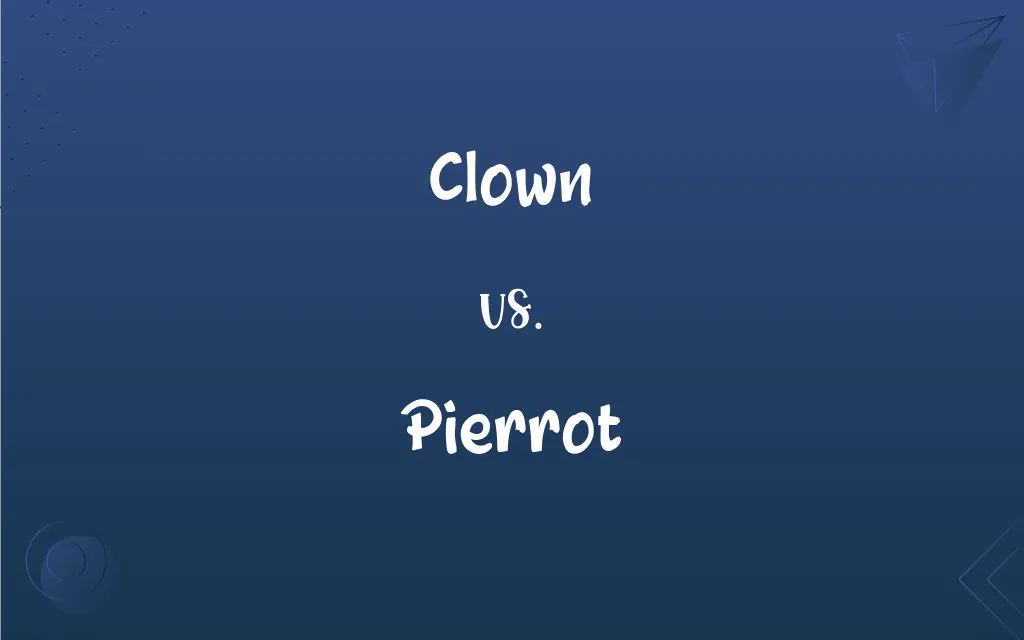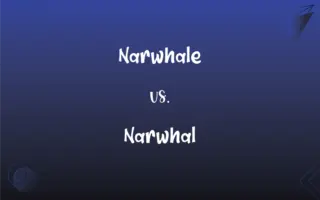Clown vs. Pierrot: What's the Difference?
Edited by Aimie Carlson || By Janet White || Updated on October 18, 2023
A "clown" is a comedic performer often characterized by colorful attire and makeup, while a "pierrot" is a specific character from French pantomime, depicted as a sad, white-faced mime.

Key Differences
The word clown generally refers to a performer known for engaging in comedic acts, typically dressed in colorful and exaggerated attire, complete with striking makeup. These performers can be found in various settings, such as circuses, stage shows, or parties. On the other hand, a pierrot is a traditional character in French pantomime. Derived from French theater, the pierrot is portrayed as a melancholic figure, characterized by its white costume and painted white face, often depicting a moonstruck lover.
Historically, the clown has roots in various cultures, dating back to ancient Egyptian and Roman times. Clowns have been seen as jesters, comedic relief, and even critics of societal norms. They possess a universal appeal, being recognized in many cultures globally. Pierrot, in contrast, has a more specific cultural origin. Emerging from the Italian Commedia dell'arte tradition and further developed in French pantomime, the pierrot character is emblematic of unrequited love, often singing about his misfortunes in love.
In terms of attire, a clown is often seen wearing oversized shoes, bright wigs, and flamboyant costumes that match their lively demeanor. Their makeup is generally bold, with exaggerated features to emphasize emotions, often making use of red noses and wide smiles. In stark contrast, the pierrot wears a loose, flowing white costume, accompanied by a skullcap. Their makeup is more subdued, with the white face often being the most dominant feature, which serves to highlight their somber expression and teardrop details.
The intention behind the performances of these two figures also varies. A clown is typically there to entertain, make people laugh, and bring joy. Their acts might include juggling, acrobatics, and other amusing stunts. The pierrot, however, often showcases acts filled with longing, sadness, or deep reflection, touching on themes of love, loss, and melancholy.
In the English language, the term clown has also been used colloquially to describe someone acting foolishly or without thought. It's a versatile word with broader usage. Conversely, the word pierrot is more specialized, not only referring to the mime character but also representing a particular emotion or theme in performance arts.
ADVERTISEMENT
Comparison Chart
Origin
Various cultures globally
French pantomime
Primary Emotion
Comedic, joyful
Melancholic, sad
Typical Attire
Colorful, exaggerated
White, simple
Makeup Style
Bold, exaggerated features
White-faced, often with teardrop
Associative Themes
Comedy, entertainment
Unrequited love, melancholy
ADVERTISEMENT
Clown and Pierrot Definitions
Clown
A character in a play or show designed for comedic effect.
The movie's clown provided much-needed comic relief.
Pierrot
A traditional figure representing melancholy in theatrical arts.
The play featured a pierrot reflecting on past regrets.
Clown
A person who acts in a silly or foolish manner.
Stop being such a clown and focus!
Pierrot
A symbol of unrequited love in French culture.
The song's lyrics echoed the sentiments of a pierrot.
Clown
An individual wearing bright makeup and clothes for entertainment purposes.
Children eagerly awaited the clown's balloon animals.
Pierrot
A character in French pantomime, depicted as a sad lover.
The pierrot sang of his lost love.
Clown
A comedic performer in a circus or show.
The clown made everyone laugh with his antics.
Pierrot
A mime with a white-painted face and loose white attire.
The pierrot's performance moved the audience to tears.
Clown
A person skilled in physical comedy, often involving slapstick.
The clown slipped on a banana peel to the audience's delight.
Pierrot
A character in French pantomime, dressed in a floppy white outfit.
Clown
A buffoon or jester who entertains by jokes, antics, and tricks in a circus, play, or other presentation.
Pierrot
Alternative form of Pierrot
Clown
One who jokes and plays tricks.
Pierrot
Any of various lycaenid butterflies of the genera Tarucus and Castalia, notable for white contrasting with brown or black on the underwings.
Clown
A coarse, rude, vulgar person; a boor.
Pierrot
(historical) An 18th-century women's low-cut basque with sleeves.
Clown
A peasant; a rustic.
Pierrot
A male character in French pantomime; usually dressed in white with a whitened face
Clown
To behave like a buffoon or jester.
Pierrot
A performer embodying the themes of longing and sadness.
The pierrot's silent act was the highlight of the evening.
Clown
To perform as a buffoon or jester.
Clown
To krump, especially in clown makeup.
Clown
A slapstick performance artist often associated with a circus and usually characterized by bright, oversized clothing, a red nose, face paint, and a brightly colored wig.
Clown
A person who acts in a silly fashion.
He was regarded as the clown of the school, always playing pranks.
Clown
A stupid or badly-behaved person.
Clown
(obsolete) A man of coarse nature and manners; an awkward fellow; an illbred person; a boor.
Clown
(obsolete) One who works upon the soil; a rustic; a churl; a yokel.
Clown
A clownfish.
Clown
To act in a silly or playful fashion.
Clown
To ridicule.
Clown
A man of coarse nature and manners; an awkward fellow; an ill-bred person; a boor.
Clown
One who works upon the soil; a rustic; a churl.
The clown, the child of nature, without guile.
Clown
The fool or buffoon in a play, circus, etc.
The clown shall make those laugh whose lungs are tickle o'the sere.
Clown
To act as a clown; - with it.
Beshrew me, he clowns it properly indeed.
Clown
A rude or vulgar fool
Clown
A person who amuses others by ridiculous behavior
Clown
Act as or like a clown
FAQs
Is the pierrot character always sad?
Typically, yes, representing melancholy and unrequited love.
What's the primary emotion associated with a clown?
Joyfulness and comedy.
Where did the clown character originate?
It has roots in various global cultures, including ancient Egypt and Rome.
Can the word "clown" also indicate someone acting foolishly?
Yes, it can be used colloquially to describe foolish behavior.
Is the pierrot character always silent?
Often, but not always, as it has roots in mime and pantomime.
Is the pierrot exclusive to French culture?
It originated in French pantomime but has been recognized in other cultures.
Do clowns always perform in circuses?
No, they can be found in various settings like stage shows or parties.
Are clowns always meant to be funny?
Primarily, but they can also evoke a range of emotions depending on context.
Do clowns have a standard outfit?
While varied, they often wear colorful and exaggerated attire.
What's the dominant makeup feature of a pierrot?
A white-painted face, often with a teardrop.
Does the pierrot character sing?
Sometimes, especially about themes of love and loss.
What color is a pierrot's attire?
Traditionally white.
Are all clowns professionals?
Not necessarily; some may dress as clowns for fun or personal events.
Is the pierrot always a male character?
Traditionally yes, but the character can be adapted and portrayed by anyone.
Do clowns have a spoken language in their performances?
Some do, while others rely on physical comedy and mime.
Is the pierrot a universal character?
While rooted in French culture, the theme it represents is universal.
Can the term "clown" be derogatory?
In colloquial usage, it can denote someone acting foolishly.
What's the significance of the pierrot's teardrop makeup?
It emphasizes themes of sorrow and unrequited love.
What emotion does a pierrot performance typically convey?
Melancholy, sadness, or longing.
Are there different types of clowns?
Yes, including jesters, harlequins, and modern circus clowns.
About Author
Written by
Janet WhiteJanet White has been an esteemed writer and blogger for Difference Wiki. Holding a Master's degree in Science and Medical Journalism from the prestigious Boston University, she has consistently demonstrated her expertise and passion for her field. When she's not immersed in her work, Janet relishes her time exercising, delving into a good book, and cherishing moments with friends and family.
Edited by
Aimie CarlsonAimie Carlson, holding a master's degree in English literature, is a fervent English language enthusiast. She lends her writing talents to Difference Wiki, a prominent website that specializes in comparisons, offering readers insightful analyses that both captivate and inform.































































